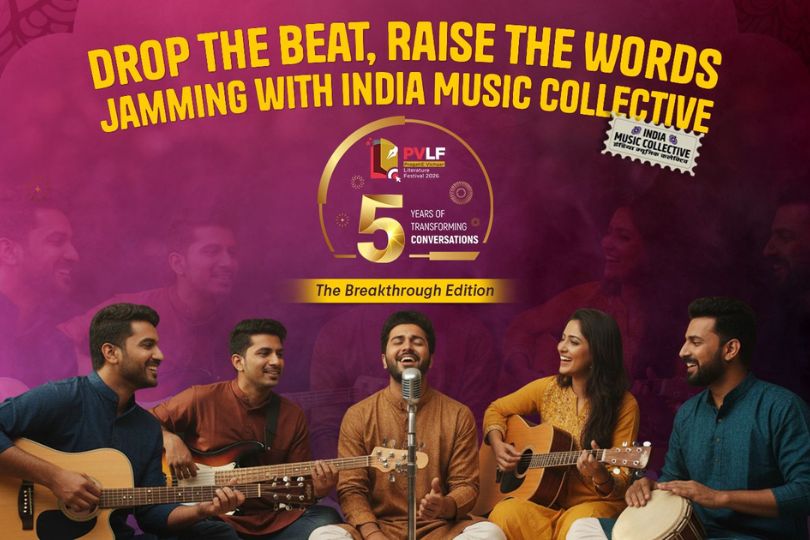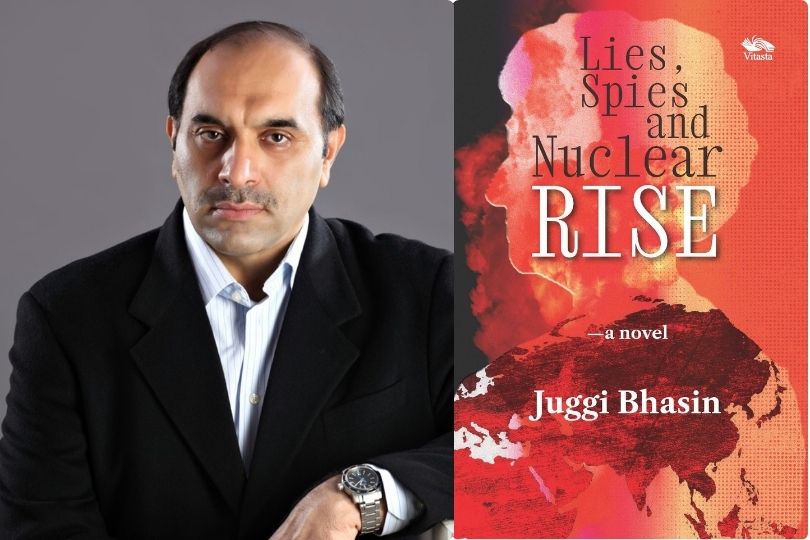Interview with Kamlesh Patel, Author of “Tales from the Vedas and Upanishads & Tales from the Puranas and Itihaas”
Dive into the world of Vedic wisdom with Kamlesh Patel, the author of 'Tales from the Vedas and Upanishads.' Explore ancient narratives in this insightful interview.on Nov 09, 2023
.jpg)
Known widely as Daaji, Kamlesh Patel is an original voice in an ancient tradition. His teachings arise from his personal experience on the path of Heartfulness, while reflecting his deep spirit of enquiry and respect for the world’s great spiritual traditions and scientific advancements. Daaji practised pharmacy in New York City for over three decades before being named as the successor in a century-old lineage of spiritual masters. Fulfilling the many duties of a modern-day guru, he extends his support to spiritual seekers everywhere. A self-professed student of spirituality, he devotes much of his time and energy to research in the field of consciousness and spirituality, approaching the subject with scientific methodology—a practical approach that stems from his own experience and mastery in the field
Frontlist: Kamlesh Patel, widely known as Daaji, could you share a bit about your journey into spirituality and authoring "Tales from the Vedas and Upanishads"?
Daaji: I was interested in spirituality right from my very young days. I read the Gospel of Ramakrishna Paramahamsa when I was in grade 5. I must have been 11 or 12 years old. It was in Gujarati and available in our village library. That book was everything to me at that time. At another instance in my life, my father sent me to the mosque, and I learned some level of discipline there. I used to do namaz also. There was so much unity in our village between Hindus and Muslims. My family read a lot of spiritual and religious books. My father would read it out to all of us, and then the elders would discuss aspects of spirituality, and we children would listen to them quietly.
A turning point came when I went to a Gurukulum. I was influenced by the guru. He used to do havan and shanti-path twice a day in the ashram. That was a fully disciplined life. They would teach us various slokas, including Bhagwad Gita, Vedas, and Upanishads. I could recite a lot of shlokas then, hundreds of them. Havan was a daily affair. Children would go out, collect their own woods, things like that, you see.
I have had exposure to practices in mosques, rituals in temples, Gurukulam, other religions, and interactions with saints. I reached the path of Heartfulness meditation and my spiritual teacher, Shri Ram Chandra of Shahjahanpur. All of these various spiritual traditions were steps leading to this ultimate moment.
Today, I have three grandchildren, with one more on the way. There are so many grandparents and parents just like me out there who want to share these rich wisdom traditions from ancient India but are trying to find the best way, as nowadays we have to do it in a contemporary way, in the way it appeals to children. When we try to share the learning or hidden wisdom from the stories, the children are naturally intrigued because, for a child, it is all about learning. Children, by nature, are very curious, and when we reveal what is hidden, in this case, the ancient wisdom, they get interested in it. So that is how these series came to be. I am eager and passionate to share all our ancient wisdom with children in a contemporary way suited for modern life.
Frontlist: "Tales from the Vedas and Upanishads" delves into the ancient Hindu texts to present 25 captivating stories. What inspired you to curate and retell these particular stories for a young audience, especially children?
Daaji: If you look at every story from both these books, "Tales from the Vedas and Upanishads" and "Tales from the Puranas and Itihaas," you can learn something very new from them. You can find a new way to solve a modern-day challenge. When we use this word - timeless wisdom - it feels cliché. But every one of these stories is a foundation for life itself. For example, the story of the two birds in the book, "Tales from the Vedas and Upanishads," is very intriguing. Imagine the surprise and wonder of a child to discover that every single human being is a version of his own highest-best self, and with that potential, if we work towards anything in life, success is sure to be ours. Now take the story of Bhagiratha in the book, "Tales from the Puranas and Itihaas". Don't we all know the phrase, "Bhagiratha Prayatna"? What does it mean? This story signifies the importance of perseverance in life.
The qualities that each story in both books shares are unique for children to imbibe. How to use anger constructively? When you tell a child, "Do not get angry," you are teaching them to suppress it. Instead, tell them how to utilize this force on themselves to become better. Thus, my choice of stories in these books stems from not merely sharing the rich cultural and spiritual heritage but also to equip children with important values, and qualities, and most importantly to create in them the art of questioning. I want to help the next generation live a meaningful, purposeful, and successful life in peace and harmony.
Frontlist: How do these stories help bridge the gap between ancient spirituality and the contemporary world? Can you share some examples of how their themes remain relevant today?
Daaji: As I already mentioned, the themes of all these stories revolve around the most important foundational aspects of life - love, compassion, sharing, respect for nature, discipline, perseverance, success, anger management, and so on. I can continue to list them all out. You have to read every single story and look at the interpretation page at the end of each story. There are a few questions, some exercises, imagery, and mental paths that a child can take towards introspection.
When a child introspects, when a child is unconsciously taught the art of questioning, with the hope of learning more about the world, wonderful things emerge. The child takes an interest, observes, and introspects more. The stories in these books make the child do all this.
In the story, "One Fruit, Two Brothers," do you see how thinking outside of the box helped Lord Ganesha in getting the wisdom fruit? Today, we need such skills to handle corporate predicaments. We talk of women-power and equality today. But it was already present in the Treta yuga, as you can see from the story of Mother Sita. We promote the idea of CSR in organizations because we want to give back to society, isn't it? When you look at the story of the Syamantaka gem, Krishna already espoused the idea of using the wealth for the common good of everyone in the land and not hoarding it by one person. So every single theme in every single story is unique and relevant for solving today's modern challenge. Not only children but also adults can learn so much from them.
Frontlist: Your book is accompanied by illustrations by Gayatri Panchpade. How do you believe these visuals enhance the reading experience and understanding of the stories?
Daaji: Look at the first story of Lord Ganesha's birth in the book, "Tales from the Puranas and Itihaas." There are beautiful symbolisms associated with Lord Ganesha. The picture depicts that his large ears and small mouth convey 'Listen to more, and talk less,' his huge head stands for knowledge, intellect, and enlightenment, and his tiny and powerful vahan, the humble mouse, is an indicator that we should be egoless and humble to such an extent that even a mouse can carry us effortlessly. The illustration conveys these qualities with explanations, too. Imagine what an impact it would make on children. Whether a very young child understands the meaning of words or not, looking at this image while the parent reads the story would make a powerful visual impact that would subconsciously feed this idea to the child.
When you look at the illustrations of the story of churning the ocean of milk, there is this beautiful spread across two pages. All that came out of the ocean of milk is depicted there. The good things, the bad things, even the poison that Lord Shiva drank, the Kalpavrikshas, etc. It is vivid with purple and gold. The child understands more than what is said using words. Something more and deeper stays in the mind. So, imagery plays a powerful role in sharing poignant ideas, especially to children. They provide a multi-dimensional approach to storytelling, enhancing the understanding and appreciation of the narratives
Frontlist: You are known for your deep inquiry into spirituality and your respect for various traditions. How did your spiritual journey influence the way you approached these ancient texts and their teachings?
Daaji: In my spiritual journey, I was exposed to silence. There is a lot of silence between words, hidden amongst sentences and generally in life, too. In this silence lie treasures. This silence has guided me to approach these ancient texts not just as written words but as gateways to the unspoken, urging children to listen to the silence between the lines, to tap into the unspoken golden nuggets of wisdom that are beyond the lines of the story. That is where I suggest children close their eyes and meditate on certain questions. Many things emerge from that kind of introspection. When I used to sit down with my spiritual teacher, Shri Ram Chandra of Shahjahanpur, we all sat around in silence for hours together. In stillness, mental clutter is absent, and creativity emerges. I treasure those silent moments and can be transported to a different realm even by merely remembering those times. I wish I could share such moments with children by asking them to introspect through these stories.
Openness to diversity, respect for ancient wisdom, spiritual practice, empathy, and compassion, are all some approaches that you would find in certain stories. However, the most important approach has been to share the contemplative approach to ancient texts, inviting children to explore the unexplored, the hidden, and the unspoken through silence.
Frontlist: Your book aims to provide insights into the meaning of life through these ancient tales. What do you hope young readers and their families will take away from this collection in terms of life lessons and self-discovery?
Daaji: Well, today's children ask very important questions: Were the Puranas and Itihaas real? Did the Ramayana and Mahabharata really happen? I may not want to give a definitive answer. I want you to be open to possibilities and approach life with a curious mind, a clear heart, a welcoming attitude, and the willingness to learn, grow, transform, and look at the bright side of life. Our attitudes towards life affect our behavior and character. Our personalities are shaped by what we believe in our minds and hearts, leading us to shape our destinies.
So, in terms of life lessons and self-discovery, when we look at all these ancient stories, we have to introspect and infer their hidden meanings. There is so much inherent symbolism. The symbolic meaning of Lord Vishnu's state of rest is that his mind is at rest, clear of desires and ego. Mother Saraswati resting on a white lotus conveys the purity of learning, symbolized by the lotus, and the attitude of detachment (vairagya), like the lotus petal. While Dasaratha, as the name indicates, means ten raths, or chariots, does it mean he can ride ten chariots simultaneously? It actually means he has complete mastery of the ten senses and faculties. Similarly, Lord Krishna was not a romantic boyfriend for the Gopis or milkmaids, but one with the wisdom and intuition of a child with spiritual abilities. There is a questioning ability in children, which is partially lost as we grow older.
Thus, stories are inherently attractive narratives and inspire us toward a good lifestyle. The selected stories from these books help in understanding the self, teach us important values and virtues, give children an aspiration for inner peace and a spiritual lifestyle, and also inculcate a heartfelt appreciation of the ancient culture and lifestyle in India. But also, let me point out that the wisdom in these books is universal in nature and has a unique application in the modern-day life of children. I also want children to transcend unconscious mental boundaries and limitations and discover the beauty of a life of love, compassion, and unity.
These stories inspire us with all of these things. And we end up emulating whatever inspires us, isn't it? Thus, we aspire to become better and reach our highest potential. When our life is driven by enthusiasm and passion that spring from our deepest Self, it fuels our imagination and opens us up to endless possibilities. That is my wish and hope for the next generation of humanity. Thank you.



.jpg)






.jpg)

.jpg)
.jpg)

.jpg)

.jpg)

.jpg)










Sorry! No comment found for this post.